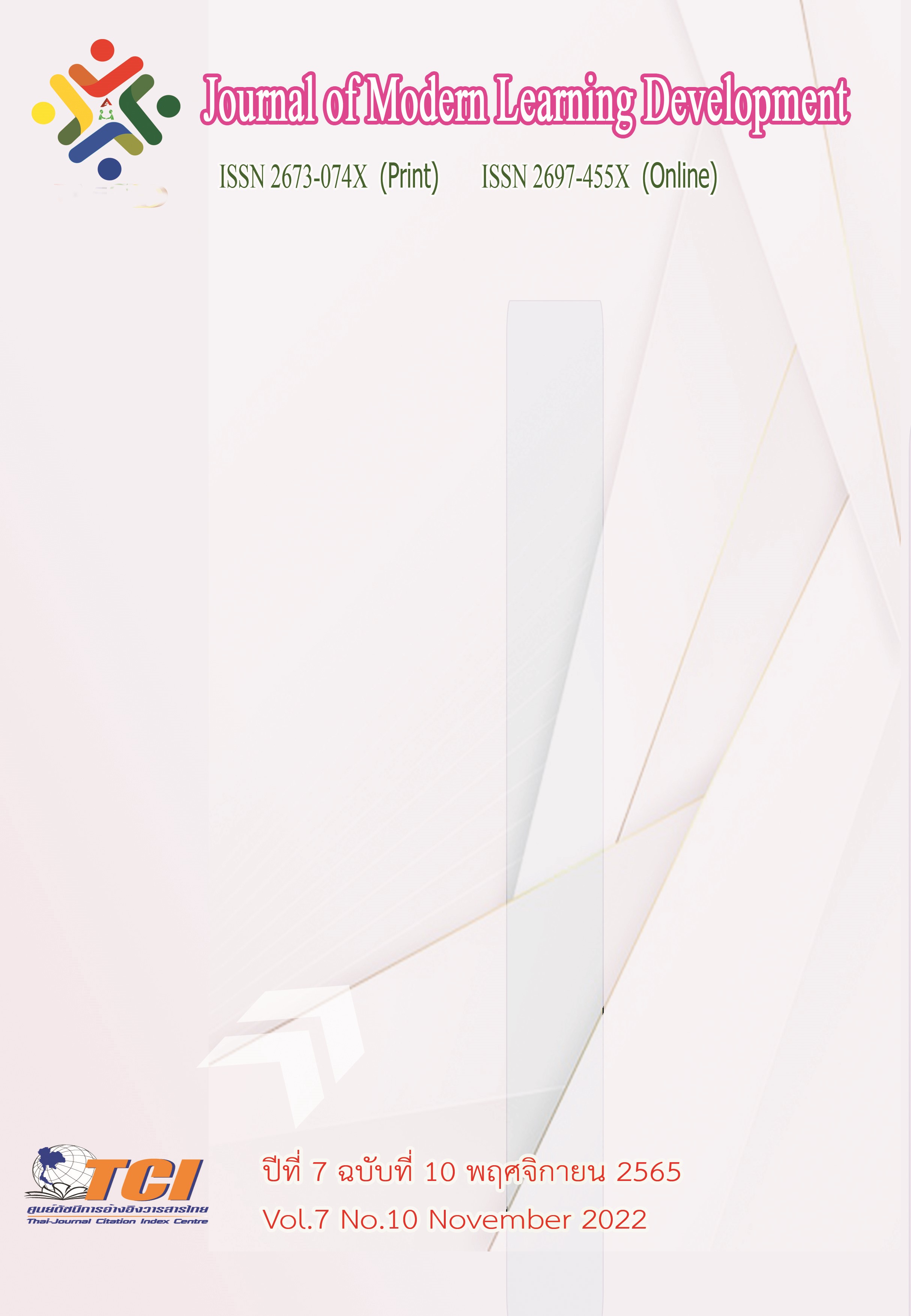The Influence of Liquidity Ratio and Cash Flows from Operation Ratio on the Return on Investment and Future Profit of Listed Companies in Property and Construction of Thailand
Main Article Content
Abstract
The purposes of this study were to study 1) The influence of liquidity ratio and cash flows from operation ratio on the return on stock investment of listed companies in property and construction of Thailand. 2) The influence of liquidity ratio and cash flows from operation ratio on and future profit of listed companies in property and construction of Thailand. The 3-year data were from the year 2018 to 2020. The data comprised of 93 t listed companies in The Market for Alternative Investment all so had not random sampling, by using record form for collecting secondary information from annual financial statements from www.setsmart.com The statistics including the Pearson’s correlation, the descriptive statistics, and the relationships were computed using multiple regression. Dependent variable are on the return on stock investment and future profit are return on assets ratio.
The following were the results 1) The influence of liquidity ratio and cash flows from operation ratio on the return on stock investment. Liquidity ratio are current ratio, quick ratio, receivable turnover, collection period, inventory turnover had not a significant effect to the return on stock investment. Cash flows from operation ratio are cashflow from operating activities per total liabilities, cashflow from operating activities per average total assets and cashflow from operating activities per net profit had not a significant effect to return on investment is the hypothesis 0.05 statistics significant level. 2) The influence of liquidity ratio and cash flows from operation ratio on the future profit. Liquidity ratio are current ratio, receivable turnover, collection period, inventory turnover had not a significant effect to the future profit but liquidity ratio are quick ratio had a significant effect to the future profit. Cash flows from operation ratio are cashflow from operating activities per total liabilities and cashflow from operating activities per net profit had not a significant effect to the future profit but cash flows from operation ratio are cashflow from operating activities per average total assets had a significant effect to the future profit is the hypothesis 0.05 statistics significant level.
Article Details
References
ธาราทิพย์ สิริจินดา (2554) . ความสัมพันธ์ระหว่างอัตราส่วนทางการเงินกับอัตราผลตอบแทนของบริษัทจดทะเบียนในตลาดหลักทรัพย์. การค้นคว้าอิสระปริญญาบัญชีมหาบัณฑิตสาขาการบัญชี คณะพาณิชยศาสตร์และการบัญชี. บัณฑิตวิทยาลัย: มหาวิทยาลัยธรรมศาสตร์.
ทิพติญา มณีบุตร และคณะ. (2563). ผลกระทบของอัตราส่วนสภาพคล่องอัตราส่วนสินทรัพย์และอัตราส่วนหนี้สินที่มีต่อผลตอบแทนจากการลงทุนของบริษัทจดทะเบียนในตลาดหลักทรัพย์แห่งประเทศไทยผล การค้นคว้าอิสระบัญชีมหาบัณฑิต คณะบัญชี. บัณฑิตวิทยาลัย: มหาวิทยาลัยศรีปทุม
นิสาชล คำสิงห์. (2560:46). ความสัมพันธ์ระหว่างอัตราส่วนกระแสเงินสดจากกิจกรรมดำเนินงานกับความสามารถในการทำกำไรของบริษัทที่จดทะเบียนในตลาดหลักทรัพย์แห่งประเทศไทกลุ่ม อุตสาหกรรมสินค้าอุปโภคบริโภค. การค้นคว้าอิสระบัญชีมหาบัณฑิต คณะบัญชี. บัณฑิตวิทยาลัย: มหาวิทยาลัยศรีปทุม.
ตลาดหลักทรัพย์แห่งประเทศไทย (2561-2563). ระบบ SETSMART ตลาดหลักทรัพย์แห่งประเทศไทย. ออนไลน์. สืบค้นเมื่อวันที่ 12 เมษายน 2565. แหล่งที่มา: https://www.setsmart.com/ ssm/login.
วนิชา เลิศพิริยสุวัฒน์. (2550). ความสัมพันธ์ระหว่างอัตราส่วนกระแสเงินสดกับความสามารถในการทำกำไรในอนาคตของบริษัทจดทะเบียนในตลาดหลักทรัพย์แห่งประเทศไทยหมวดอุตสาหกรรมยานยนต์. การศึกษาค้นคว้าอิสระ บัญชีมหาบัณฑิต. บัณฑิตวิทยาลัย: มหาวิทยาลัยธรรมศาสตร์.
ชยพล วงศ์เตชะ (2558). ความสัมพันธ์ระหว่างอัตราการส่วนกระแสเงินสดจากกิจกรรมดำเนินงานกับความสามารถในการทำกำไร บริษัทจดทะบียนในตลาดหลักทรัพย์แห่งประเทศไทย หมวดเทคโนโลยี
สารสนเทศและการสื่อสาร. การประชุมวิชาการระดับชาติ ครั้งที่ 2 มหาวิทยาลัยธุรกิจบัณฑิตย์. 1-12.
เพ็ญนิภา พรหมโคตร และคณะ. (2560). กระแสเงินสด ผลตอบแทนของหลักทรัพย์ และผลการดำเนินงานของบริษัทจดทะเบียนในตลาดหลักทรัพย์ เอ็ม เอ ไอ. วารสารบริหารธุรกิจและการบัญชี มหาวิทยาลัยขอนแก่น. 1 (3), 35-50.
แก้วมณี อุทิรัมย์. (2556). ความสัมพันธ์ระหว่างอัตราส่วนทางการเงินกับผลตอบแทนที่คาดหมายของบริษัท ที่จดทะเบียนในตลาดหลักทรัพย์แห่งประเทศไทย กรณีศึกษากลุ่มอุตสาหกรรมเทคโนโลยี. วิทยานิพนธ์ปริญญาบริหารธุรกิจมหาบัณฑิต. บัณฑิตวิทยาลัย: มหาวิทยาลัยศรีปทุม


